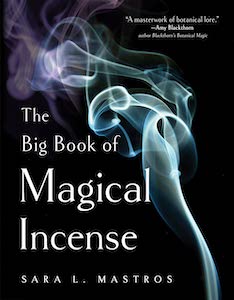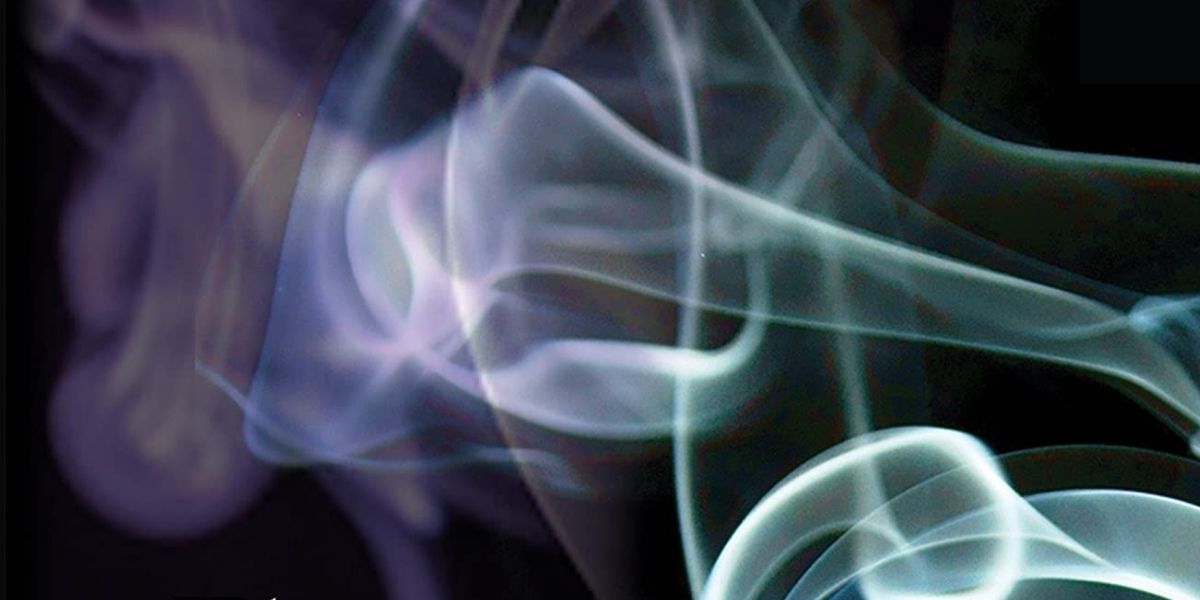
The Big Book of Magical Incense, by Sara L. Mastros
Weiser Books, 1578637406, 288 pages, December 2021
The thing that often comes to mind when I think of the modern witch, and most likely does for others as well, is the silhouette of a person obscured by heavy smoke in a sweet heavy scented air. But how do we create this sort of ambiance? Why with incense of course! But how do we get incense? The Big Book of Magical Incense by Sara L. Mastros has everything you need to know when taking your first baby steps into the world of incense craft. This book touches on the history, the how to burn, the forms of incense and much more.
All of these chapters are for the most part short, sweet, and to the point. For instance, the chapter “A very Brief History of Incense in the West” clocks in at a whopping three pages! A very informative three pages, but three pages nonetheless. It was so easy to say “just one more chapter” while reading, making this a very quick book to get through.
Just because it’s a relatively quick read doesn’t mean it’s a one and done title. Subsequent readings may not have any new information jump out at you, but refreshing your knowledge on such an important topic in the craft periodically is invaluable.
The Big Book of Magical Incense is divided into three main parts: fundamentals, ingredients, and recipes. Each chapter within these sections is appropriately titled and numbered for quick reference.
There’s a well-implemented table of contents too, which is important since being able to find your way around a book this size is quite a feat. In the event that said chapter has sub categories, much like the “How to Prepare Loose Incense”, they are included under the chapter name on an indented line almost like a citation in an APA formatted paper. Thus, making the process of locating certain topics a breeze. No going to the index in the back to get to the making cone incense section: it’s front and center.
The way the notes and citations were done confused me before I realized they were all together, in one place, at the back starting on page 259. I much prefer this method of having all the citations in one section toward the back, where I can stick a bookmark and refer to them at my leisure, rather than having them tacked onto the bottom of the pages they appear on.
“This book isn’t intended for your library, but for your laboratory, where you get your hands dirty and try things.”1
This is a claim made by our author, but there’s a part of me that isn’t too convinced. My first and pretty much only point of contention with that statement is that this book appears to only come as a paperback and doesn’t have a hardcover option.
I have always been rough with my most used tools; there are composition books that have seen better days in my possession. Covers worn clean off and some hand-stitched back together so as to preserve the tea ring on page 25 from that one late-night flip though gone slightly wrong. Even though it would mean a price increase, I’d love to see a hardcover version of this at some point, so it could be more durable for my experiments.
Whelp, with my only real issue out of the way, let’s give this wonderful title some praise. First up on the praise block has to be the margins. There is so much empty space around the text that’s straight up free real estate for notes. This is just *chef’s kiss*.
Giving us all that space to make our notes and alterations to our Mastros’ printed word was such an amazing design choice. It really makes it feel like this is a workbook that deserves a place at the bench of magical workings. Being able to mark-up the rituals and exercises presented to us right in the book that will be going into the sacred space of said working, in my opinion, is invaluable. You’re able to get the most accurate to the moment notes as possible by being able to write right in the book.
A thing that I feel the need to address is that Mastros does mention White Sage and Palo Santo in the ingredients section. But these materials were treated with the respect they deserve. The problematic nature of the way modern markets have treated these sacred and powerful pieces of nature is addressed and substitutions are given for both substances.
The coverage was not very extensive but that is to be expected. This is a book on incense, not the sketchy way big business is making money by harming and mistreating plants. That’s something for us to do research on in our own time.
Another thing I love about this book is the emphasis placed on the customization of the recipes/blends given to us by Mastros. Newcomers to the world of incense, and to the practice in general, seem to get so bogged down in the notion that they need to do things EXACTLY like the way the books say. But this is a personal practice for the most part, you do what feels right and gets you the desired outcome.
Person A may not use Lavender in a calming blend because they don’t see it as a calming herb, whereas I do. And in the same vein, someone else may have no qualms with including tobacco in an ancestor incense, but I would never as tobacco smoke is one of my migraine triggers. In the words of Captain Barbosa from the Pirates of the Caribbean series, “The code is more what you’d call ‘guidelines’ than actual rules.” There’s no shame in changing it up.
Who do I think would benefit from this book? The short answer is everyone. Never used incense? Completely new to the concept? No biggie! There’s just enough info here to get you started in the dirty work of blending right away as well as lay the groundwork for a good foundation upon which to build up with further research.
Do you have a mid to high level of experience with this stuff? The personal blends and exercises/rituals that pair with said blends might just tickle a mental itch you didn’t know you had and reading Mastros’ take on these things may have you rethinking your personal beliefs/philosophy on incense and its place in your craft. The wealth of knowledge in The Big Book of Magical Incense is a bonafide steal.

Antoinette Aird is a lifelong creator of whatever pleases her, thank you very much. Be it short stories that never see the light of day or ramblings on items she loves. When she’s not shouting at the neighbor chickens for pecking at her garden or reading you can find her attempting various methods of divination or trying to befriend the local stray cats. Antoinette has a lot of thoughts floating around in her brain and is willing to share them. Come and sit for a spell…
